Science & Environment
Soft landing hit by minor turbulence
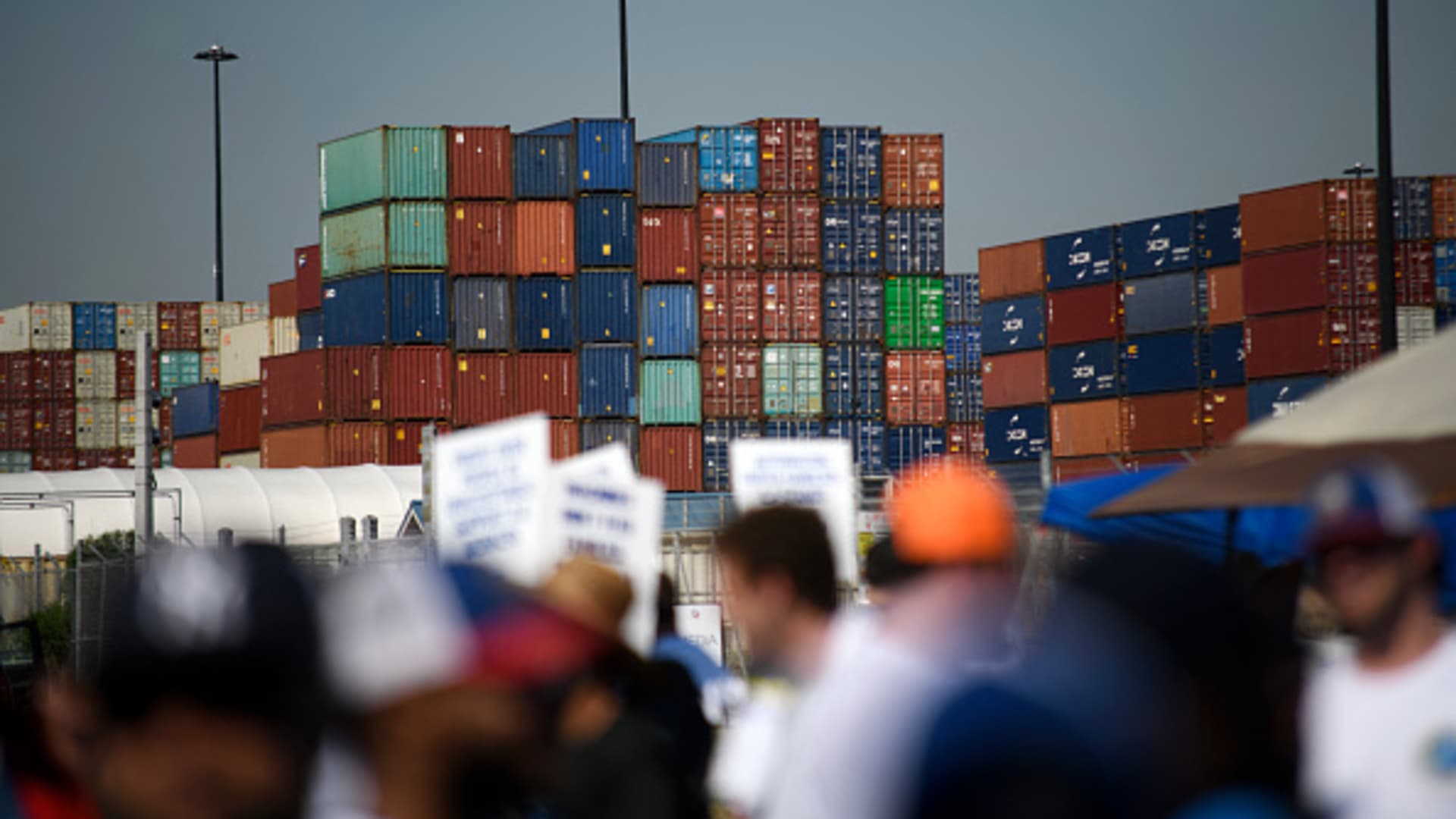
Dockworkers strike at the Bayport Container Terminal in Seabrook, Texas, on October 1, 2024.
Mark Felix | Afp | Getty Images
This report is from today’s CNBC Daily Open, our international markets newsletter. CNBC Daily Open brings investors up to speed on everything they need to know, no matter where they are. Like what you see? You can subscribe here.
What you need to know today
U.S. stocks shaken as Hong Kong market rallies
U.S. stocks fell on fears over growing geopolitical tensions. The S&P 500 slipped 0.93%, the Dow Jones Industrial Average lost 0.41% and the Nasdaq Composite retreated 1.53%. Hong Kong’s Hang Seng index popped around 5%, propelled by the year’s strongest rally in Hong Kong-listed Chinese property stocks.
Escalating Middle East conflict
Prices of WTI and Brent oil rose around 1.6% during Asian trading hours as conflict escalated in the Middle East. On Tuesday, Israel began a ground offensive in Lebanon and Iran launched a ballistic missile attack on Israel. Analysts told CNBC there’s a chance Israel will hit Iran’s oil infrastructure, which could cause oil to spike to more than $100 a barrel.
Widespread effect of port strike
Members of the International Longshoremen’s Association started striking Tuesday, halting activity at U.S. East Coast and Gulf Coast ports, which stretch from Maine to Texas. If the strike drags on, global supply chains and the economy could take a beating. That runs the risk of causing inflation to flare up again.
Risk-off on crypto
Amid this cautious atmosphere, investors pulled back from cryptocurrency. Bitcoin is currently trading at $61,407.21, down from nearly $66,000 on Sunday. Crypto-related companies also struggled on Tuesday. Coinbase tumbled 7.4% and fell around 1% in extended trading.
[PRO] Fund manager’s worst-performing stock
Ranmore Global Equity Fund managed to beat the S&P the past two years. But there have been slip-ups as well. Its fund manager shares with CNBC the worst-performing stock he’s picked: why he bought it, what went wrong and the lessons he learned.
The bottom line
Just when the coast appeared clear, geopolitical tensions and potential supply chain snarl-ups threaten to turn the soft-landing trajectory into a bumpy one.
Port workers along the U.S. East Coast and Gulf Coast started striking Tuesday. At a port in the New York-New Jersey area, around 100,000 shipping containers “are literally in limbo in the port,” said New York Governor Kathy Hochul.
“A disruption of a week or two will create some backlogs but the broader consequences will be minimal,” said Adam Kamins, economist at Moody’s Analytics.
Should the work stoppage go on for longer, however, “you’re running into businesses that have real shortages and, yeah, they’ll absolutely have to raise those prices,” said Christopher Ball, economics professor at Quinnipiac University.
(Fans of Rao’s pasta sauce need not fear, for now. Piper Sandler wrote that Campbell Soup, which bought Rao’s earlier this year, “has healthy levels of inventory on hand.”)
Meanwhile, oil prices spiked as markets feared Iran, a member of OPEC, would be dragged into a larger conflict in the Middle East. Higher oil prices pose a risk to inflation resurging, or at least slowing less than everyone is hoping for.
With those fears and uncertainties swirling, the Cboe Volatility Index, known as Wall Street’s fear gauge, climbed to 19.3 on Tuesday. It closed at 15.4 a week ago. Major U.S. indexes fell, with the tech-heavy Nasdaq suffering the most as megacaps like Tesla, Nvidia and Apple dropped.
It’s just the first days of the port strike and flare-up in Middle East tensions, however. The classic safe-haven trades, like bonds, gold and the U.S. dollar, aren’t showing up in the prices of those assets yet, noted CNBC’s Steve Liesman.
The best-case scenario would be that recent events are just minor turbulence on the way to a soft landing.
– CNBC’s Jeff Cox, Fred Imbert, Lori Ann LaRocco, Sean Conlon, Alex Harring and Brian Evans contributed to this story.
Science & Environment
Crude oil jumps nearly 3% as Israel vows ‘painful’ response to Iran missile attack
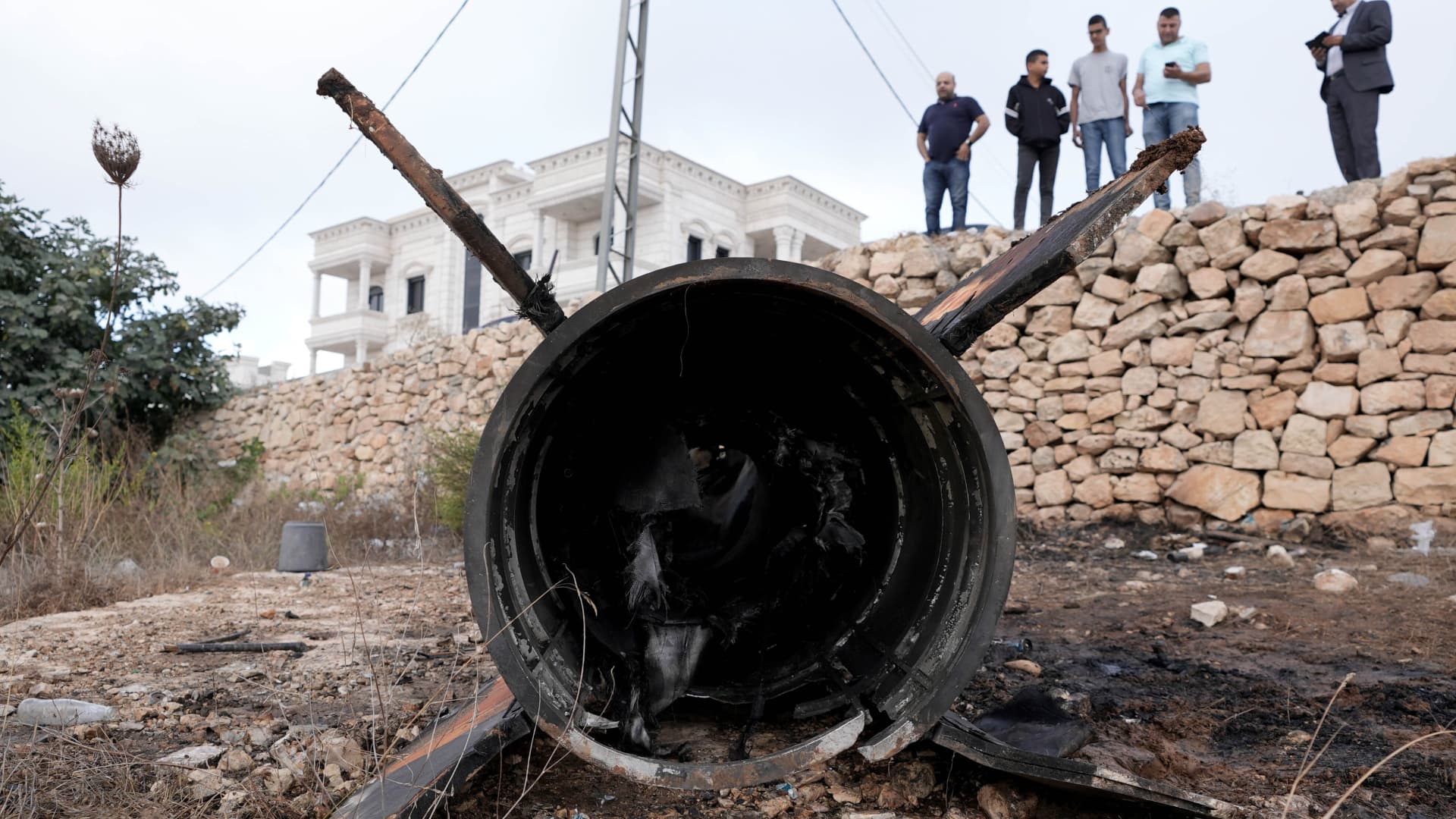

U.S. crude oil rose nearly 3% on Wednesday as traders fear Israel could target Iran’s oil infrastructure in retaliation for a ballistic missile attack.
Israel’s ambassador to the United Nations, Danny Danon, vowed late Tuesday that Israel will exact a “painful” response against Iran. Danon’s threat came hours after the Islamic Republic launched around 180 ballistic missiles at Israel in retaliation for the assassination of top Hamas and Hezbollah leaders.
Here are Wednesday’s energy prices:
- West Texas Intermediate November contract: $71.86 per barrel, up $2.03, or 2.91%. Year to date, U.S. crude has gained less than 1%.
- Brent December contract: $75.50 per barrel, up $1.94, or 2.64%. Year to date, the global benchmark is down about 2%.
- RBOB Gasoline November contract: $2.0113 per gallon, up 2.27%. Year to date, gasoline is down nearly 5%.
- Natural Gas November contract: $2.984 per thousand cubic feet, up 3.04%. Year to date, gas is up nearly 19%.
“The next turn in this retaliation spiral may very well involve oil – via the degrading of Iran’s oil capacity or Iran’s proxies attacking oil and gas shipping from the Persian Gulf,” Piper Sandler analysts told clients in a Wednesday note. Israel might take aim at Iran’s oil industry to hit Tehran’s income and degrade its ability wage war, they said.
The geopolitical risk premium, however, should remain moderate given high spare oil capacity globally and the fact that there have been limited actual production disruptions, Goldman Sachs analyst Yulia Zhestkova Grigsby told clients Wednesday.
OPEC+ is planning to increase oil production in December, and U.S. output has been set records. Demand in China, the world’s largest crude importer, has also been soft this year.
Science & Environment
Markets watch for dangers of further escalation
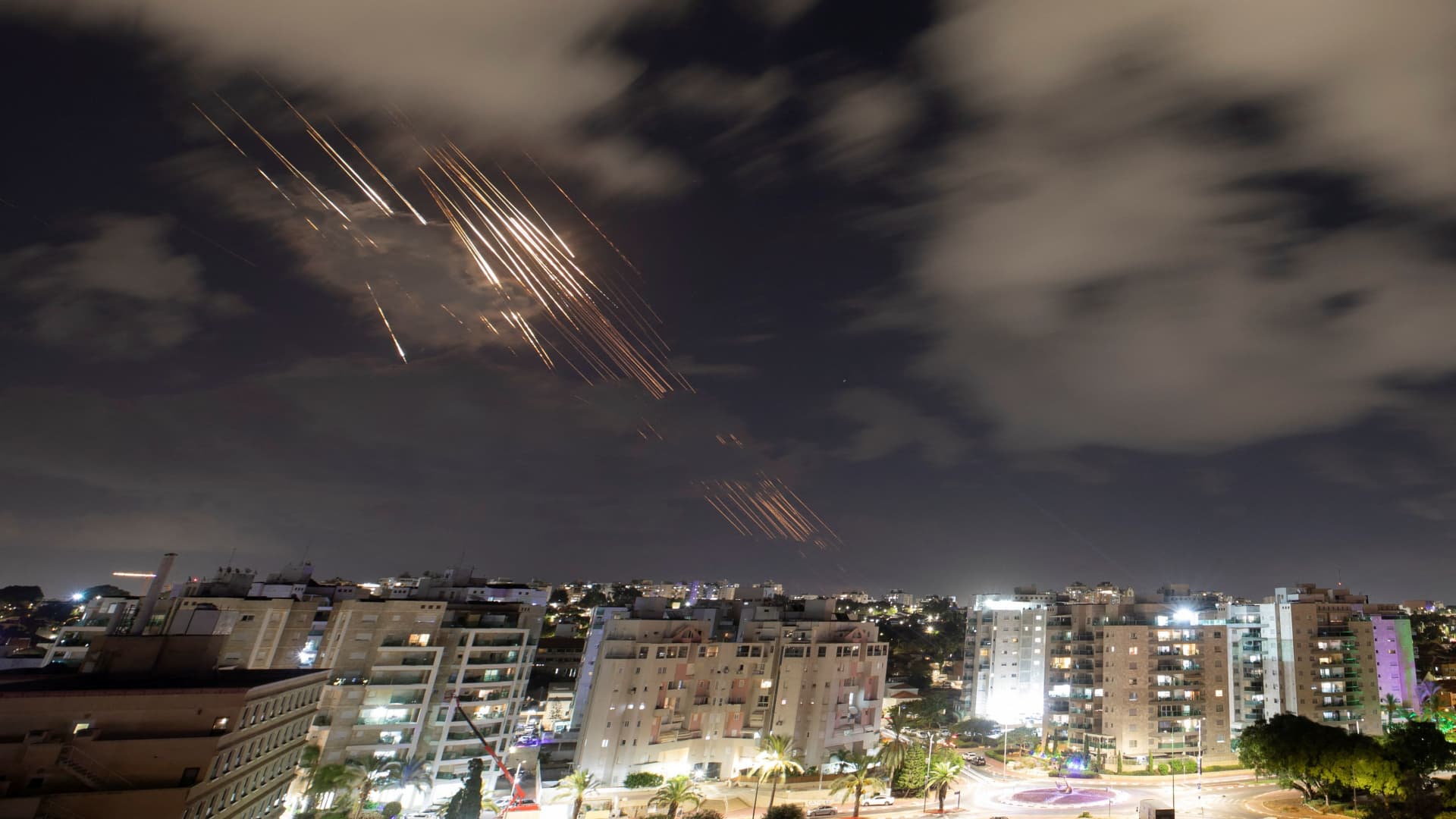
Israel’s Iron Dome anti-missile system intercepts rockets, as seen from Ashkelon, Israel, October 1, 2024
Amir Cohen | Reuters
Israel’s government has vowed a severe response to Iran’s unprecedented missile barrage into Tel Aviv, leaving the Middle East on edge as fears rise over a possible all-out war between the two long-time foes.
On Tuesday evening, Iran launched roughly 180 ballistic missiles at several sites across Israel, an attack Tehran said came in response to the Israeli assassination of Hezbollah chief Hassan Nasrallah the week prior.
Israeli authorities say there were no casualties as a result of the offensive, and that most of the strikes were intercepted. But the event marked a turning point in a series of escalatory tit-for-tat moves, as Tehran appeared adamant to re-set deterrence and prove to Israel that it could — and would — attack at a time of its choosing.
Markets are now braced for what could follow a likely Israeli retaliation against Iran. Defense stocks are rallying — and long-subdued oil prices may also be set for increases, as industry watchers now see a real threat to crude supplies.
As much as 4% of global oil supply is at risk as oil infrastructure in Iran — one of OPEC’s largest crude producers — could become a target for Israel.

Oil prices gained over 5% in the previous session following the missile strike, before tapering to a 2.5% climb. The December delivery contract of global benchmark Brent was trading at $75.37 per barrel at 10:30 a.m. in London, while front-month November U.S. West Texas Intermediate futures were up 2.68% to $71.70 per barrel.
“I think this focus might be on Israel, but the focus should really be on Iran, and whether there will be attacks on regional infrastructure. That really is the one event that we are looking for, and which could determine a more dangerous path for stock markets, for risk assets in general,” Frederique Carrier, head of investment strategy for the British Isles and Asia at RBC Wealth Management, told CNBC’s Capital Connection on Wednesday.
“We know, looking at the acts of war since the 1940s, that those which create an oil crisis [and] a prolonged increase in oil prices are the ones which have a long-lasting impact on stock markets.”
She added that so far, there is “no indication” of that.
Oil infrastructure ‘tempting targets for Israel’
Lewis Sage-Passant, an adjunct professor of intelligence at Sciences Po in Paris, described energy markets as jittery, as investors watch for Israel’s next moves.
“Iran depends on a handful of ‘chokepoint’ export terminals, such as Khark island, which will be tempting targets for Israel,” Sage-Passant said. “Energy sector teams seem nervous about an escalating tit-for-tat of strikes against regional infrastructure. Even without direct targeting, much of the world’s oil infrastructure sits under these missile’s flight paths, so naturally everyone is very nervous.”
Following the Tuesday attack, U.S. National Security Advisor Jake Sullivan warned of severe consequences for Iran, saying that the U.S. would staunchly support Israel. But Washington’s efforts to de-escalate and prevent a region-wide conflict have clearly failed, according to Roger Zakheim, a former U.S. deputy assistant defense secretary and director of the Ronald Reagan Institute in Washington.

Iran’s attack and the subsequent Israeli response “may result in impact on oil, energy markets, certainly aviation, and I think certainly the defense sector … Investments in missile defense and ammunition, those companies that manufacture and produce those systems, for sure are going to be impacted by what’s playing out in the Middle East,” he said.
Immediately following the Iranian strikes, U.S. defense stocks hit record highs. Their European counterparts also ticked higher on Wednesday morning on the rising conflict risks, with Saab and BAE Systems adding 2.2%. Thales and Rheinmetall both rose more than 1.3%.
“Israelis now will respond, not only in kind, but do what is necessary to restore deterrence,” Zakheim added.
Deterrence, or full-blown war?
Questions remain whether a strong Israeli response would restore deterrence or trigger further escalation from Iran and tip the nations into a full-blown war. In a statement following the country’s missile salvos, Iran’s Foreign Minister Abbas Araghchi said: “Our action is concluded unless the Israeli regime decides to invite further retaliation. In that scenario, our response will be stronger and more powerful.”
Aside from geographical choke points in the oil market, “there are plenty of facilities on [the] Iranian side and also [on the ] Israeli side that could all be targeted in terms of critical infrastructure,” Sara Vakhshouri, founder and president at SVB Energy, told CNBC’s Capital Connection on Wednesday.
“That infrastructure is all connected,” she said, stressing that the sheer size of Iran means “it is impossible to somehow secure all of it.”

Some market watchers are warning oil could hit $100 per barrel.
Vakhshouri expressed doubts over such a forecast, noting that geopolitical events often only affect oil prices temporarily. The extent and duration of any market impact “depends on where the destruction would be and how much oil is going to be taken off the market,” she said.
“Definitely, prices will have an upward trend. [But] the other thing is that the market is focusing on huge uncertainty on both sides … [whether] it’s the demand side or the geopolitical side.”
A longer-term issue underpinning oil prices is the broader global demand picture. Brent crude hit a 33-month low in mid-September and had hovered around $70 per barrel until Iran’s missile attack on Israel, based on slowing global demand and abundant supply, particularly from non-OPEC+ producers.
“So it’s very interesting moment now,” Vakhshouri said. “We have the prices being resilient due to the fear of low demand in the market, but also the geopolitical factor is real. Any side could really push the market, and we have seen just in the past few days, how the prices go up and down, depending on how the sentiments are triggered in the market.”
Science & Environment
Time to walk away from the net zero fantasy

Andrew Forrest, chairman of Fortescue Metals Group Ltd., during the Asia-Pacific Economic Cooperation (APEC) CEO Summit in San Francisco, California, US, on Thursday, Nov. 16, 2023.
Bloomberg | Bloomberg | Getty Images
Australian mining tycoon Andrew Forrest, founder and executive chairman of Fortescue, says it is time for the world to walk away from the “proven fantasy” of net zero emissions by 2050 and to embrace “real zero” by 2040 instead.
Speaking to CNBC’s “Street Signs Europe” on Wednesday, Forrest called on business executives and politicians reluctant to make the changes necessary to avert the worst of what the climate crisis has in store to make way for leaders willing to take on the decarbonization challenge.
Fortescue, which is the world’s fourth-largest iron ore miner, has outlined plans to stop burning fossil fuels across its Australian iron ore operations by the end of the decade — and urged other hard-to-abate companies to follow suit.
“All those leaders who say to me, say to the world, say to their kids, ‘oh you know we can’t do it, my company can’t do it, I can’t do it, you don’t understand we can’t actually do it,’” Forrest said in an exclusive interview.
“What they are really saying is that you can’t do it. And I’m saying to each of those chief executives and those political leaders who use the words ‘I can’t,’ OK, what about you get off the stage and let on a young girl or wiser leader who can. Someone with a bit of ticker because the technology is there,” he continued.
“We know the world can go real zero 2040 and I’m reaching out to the business people and politicians across our planet to say it is time now to walk away from this proven fantasy [of] net zero 2050 and adopt real zero 2040,” Forrest said. “We can, we must, let’s do it.”
Net zero refers to the goal of achieving a state of balance between the carbon emitted into the atmosphere and the carbon removed from it.
More than 140 countries, including major polluters such as the U.S., India and the European Union, have adopted plans to reach net zero.
A hydrogen-powered haul truck, right, at the Fortescue Metals Group Ltd. Christmas Creek mine in the Pilbara region of Western Australia, Australia, on Tuesday, Oct. 17, 2023.
Bloomberg | Bloomberg | Getty Images
To meet the critically important warming threshold of 1.5 degrees Celsius, a target ascribed in the landmark Paris Agreement, global carbon emissions should reach net zero by around the middle of the century, according to the Energy and Climate Intelligence Unit non-profit.
For high-income nations, such as the U.S., it means reaching net zero by 2050 or earlier, while for low-income countries, it can mean achieving net zero by the 2050s or 2060s.
What is ‘real zero’?
“Real zero is the ability of this planet to use the technology it has right now. It’s evolving and it’s getting better very quickly, but to use the technology we have right now to stop burning all fossil fuels by 2040,” Forrest said.
“If we did that by 2030, we’ve got a 50:50 chance of avoiding the worst ravages of global warming — that’s not going to happen. Fortescue is going to make it happen. We’re a huge industrial company, massive polluter, we’ll go real zero. We’ll stop burning all fossil fuels easily this decade, not next, this decade,” he added.
“And we’re saying to the world, if you want to hold that planetary boundary to a future which is inheritable, tolerable for your kids then we must go real zero. We must stop burning fossil fuels by 2040,” Forrest said.
A worker walks in the Green Hub area of the Fortescue Metals Group Ltd. Christmas Creek mine in the Pilbara region of Western Australia, Australia, on Tuesday, Oct. 17, 2023.
Bloomberg | Bloomberg | Getty Images
Scientists have repeatedly pushed for rapid reductions in greenhouse gas emissions to stop global average temperatures rising.
These calls have continued through an alarming run of temperature records that have put the planet firmly on course to notch its hottest year in human history in 2024.
Extreme temperatures are fueled by the climate crisis, the chief driver of which is the burning of fossil fuels.
Science & Environment
Yale’s Stephen Roach warns of global volatility, ‘whipsawed’ markets
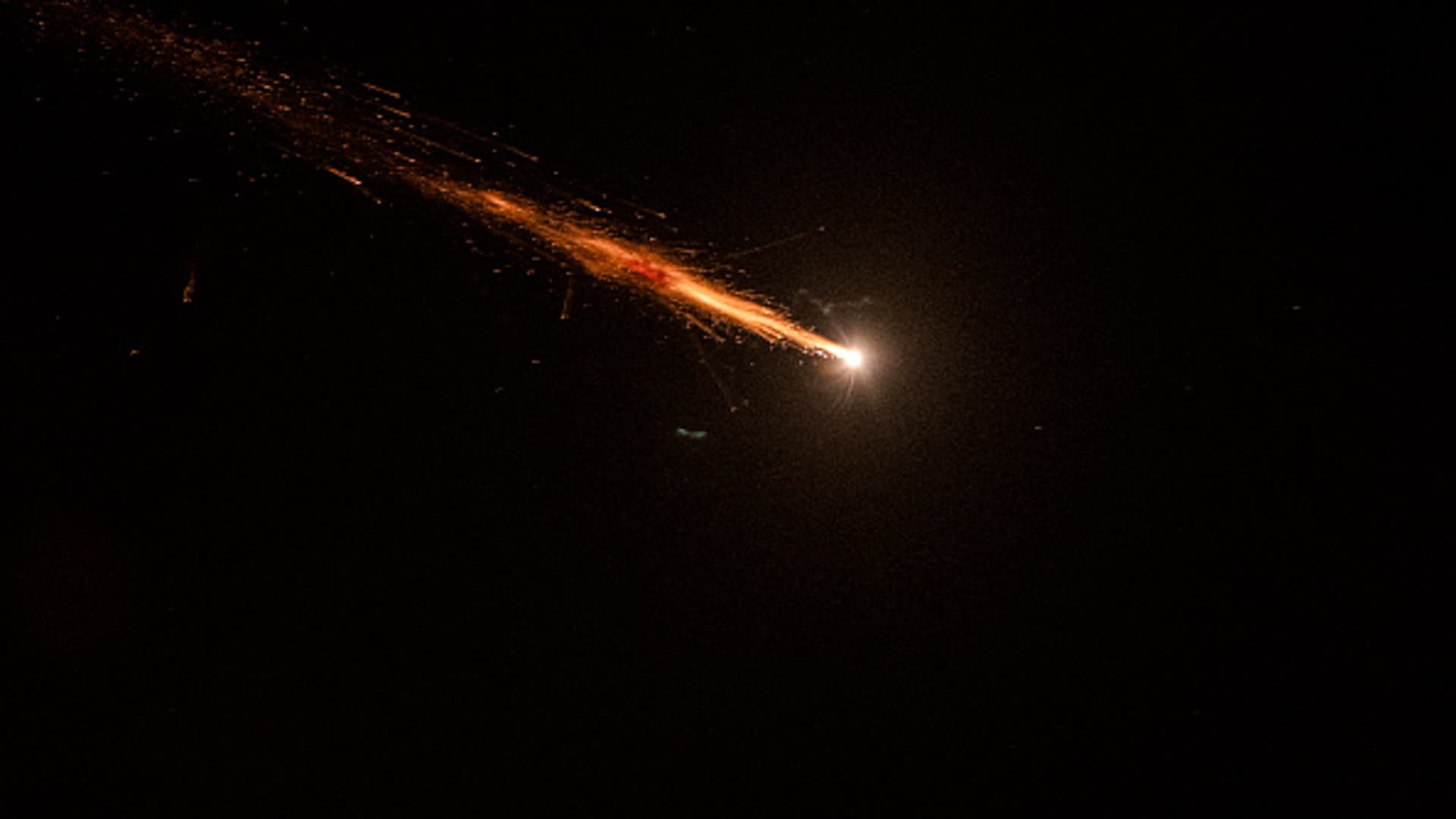
01 October 2024, Israel, Tel Aviv: Missiles launched from Iran are seen in the sky over Tel Aviv.
Ilia Yefimovich/dpa | Picture Alliance | Getty Images
Markets are in danger of being “whipsawed” by the combination of regional conflict in the Middle East and rising unemployment in the United States, says Stephen Roach, senior fellow at Yale Law School’s Paul Tsai China Center.
The conflict in the Middle East escalated on Tuesday, with Iran launching a ballistic missile attack on Israel after its killing of Hezbollah leader Hassan Nasrallah and an Iranian commander in Lebanon.
Most Asian markets fell on Wednesday, tracking losses on Wall Street overnight, as investors fretted over rising tensions in the Middle East.
“The markets really will not know where to turn,” Roach said, adding that conflicts in the Middle East are adding to inflationary risks at a time when global central banks are starting to ease monetary policy.
“We are likely to see significant increases in volatility and markets that really are whipped back and forth dramatically,” Roach told CNBC’s “Squawk Box Asia” on Wednesday.
Oil market impact
The Israel Defense Forces said its troops had started launching new strikes against Hezbollah targets in Lebanon in response to Iran’s missile attack Tuesday night.
It remains to be seen whether there will be lasting effects on inflation, said Stephen Stanley, chief economist at Santander, adding that the oil market will be “affected more significantly” if the tension escalates.

Iran is the third-largest producer among the Organization of the Petroleum Exporting Countries, pumping out nearly four million barrels of oil per day, according to the Energy Information Administration. Oil prices had jumped over 5% after the missile strike before tapering to a 2% climb.
Outlook for interest rates
The Israeli response to Iran’s attacks “might throw the Fed’s 25-basis-point rate cut off track,” said Kelvin Tay, regional chief investment officer at UBS Global Wealth Management.
The U.S. Federal Reserve projected cutting interest rates by another half point over the next two policy meetings this year, according to the central bank’s so-called dot plot from the September meeting.
Traders are also looking to U.S. payroll data on Friday for more indications on the state of the economy after the U.S. Federal Reserve’s jumbo rate cut in September. A higher-than-expected unemployment rate could prompt the Fed to accelerate the easing cycle to achieve a soft landing.
The unemployment rate in September is expected to come in at 4.2%, according to data of a Reuters poll on LSEG, unchanged from the August figure. The unemployment rate had jumped to near a three-year high of 4.3% in July, a dramatic rise from the five-decade low of 3.4% in April 2023.

Another factor that could affect the Fed’s rate-cutting pace is how long dockworkers’ strikes at the U.S. East and Gulf coasts will last, Tay said.
Dockworkers at ports stretching from Maine to Texas have gone on a large-scale strike over disputes on wages and threats from automation. It’s expected to disrupt global supply chains and has halted the flow of nearly half of the country’s ocean shipping, Reuters reported.
“Any disruption of the port, any work stoppage at the port is going to have a very significant economic consequence and very quickly,” said Peter Tirschwell of S&P Global Market Intelligence, warning that “the longer this goes on, the quicker the economic damage will mount.”
Science & Environment
Oil watchers now see a real threat of supply disruptions after latest Iran-Israel escalation
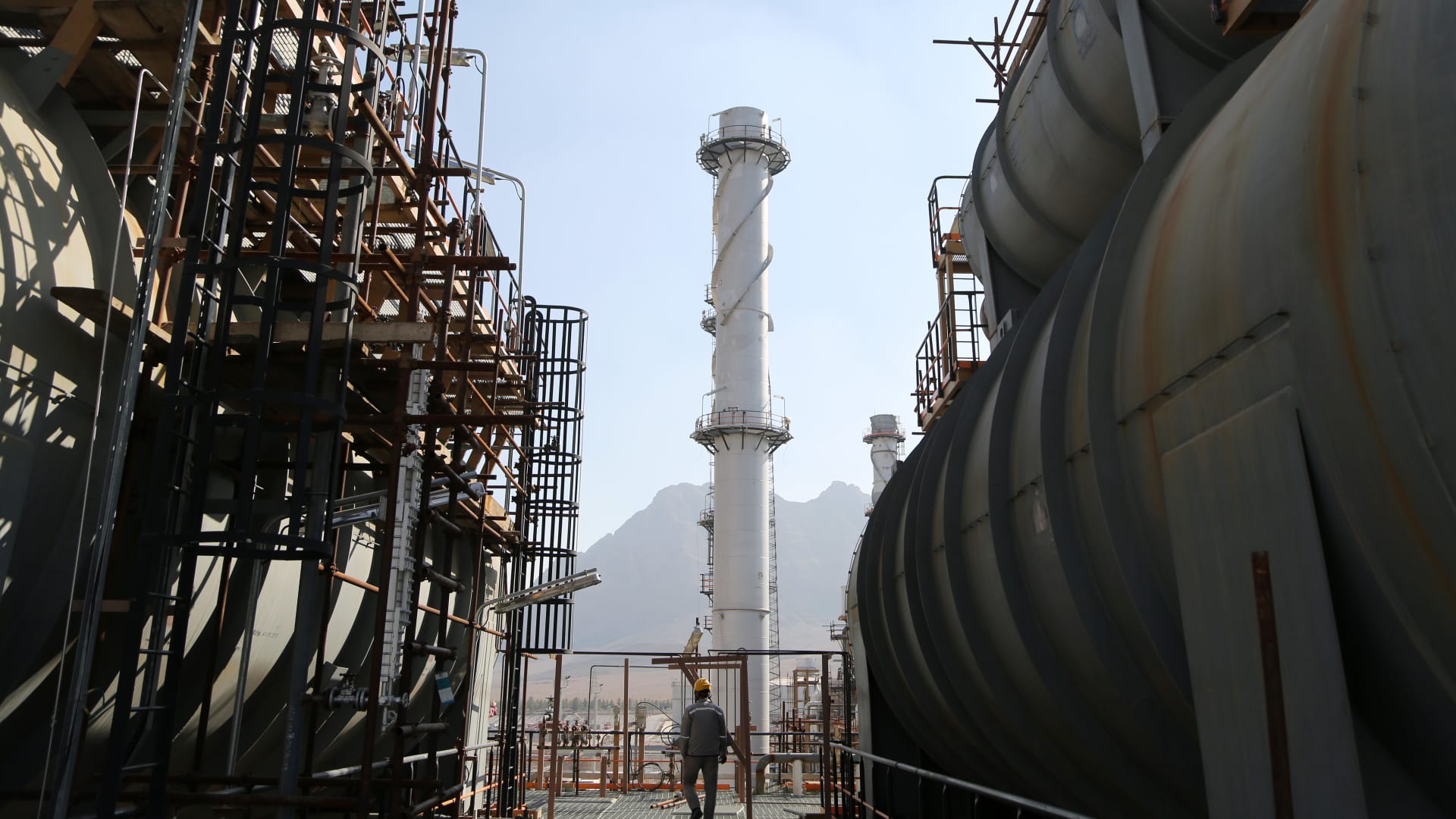
A general view of Isfahan Refinery, one of the largest refineries in Iran and is considered as the first refinery in the country in terms of diversity of petroleum products in Isfahan, Iran on November 08, 2023.
Fatemeh Bahrami | Anadolu | Getty Images
Oil watchers are now seeing a genuine threat to crude supplies after Iran launched a ballistic missile attack on Israel, escalating conflict in the Middle East.
Iran on Tuesday launched the strike on Israel in retaliation for its recent killing of Hezbollah leader Hassan Nasrallah and an Iranian commander in Lebanon.
Iranian oil infrastructure may soon become a target for Israel as it considers a countermove, analysts told CNBC.
“The Middle East conflict may finally impact oil supply,” said Saul Kavonic, senior energy analyst at MST Marquee. “The scope for a material disruption to oil supply is now imminent.”
These latest developments could be a gamechanger, after a prolonged period of “geopolitical risk fatigue” during which traders brushed off threats of oil supply disruptions stemming from the situation in the Middle East as well as Ukraine, he said.
Up to 4% of global oil supply is at risk as the conflict now directly envelopes Iran, and an attack or tighter sanctions could send prices to $100 per barrel again, Kavonic added.

Oil prices year-to-date
Iran’s latest missile attack followed Israel’s deployment of ground troops into southern Lebanon, intensifying its offensive against Hezbollah, the Iran-backed militant group. Most of the 200 missiles launched were intercepted by Israeli and U.S. defenses, and there were no reported fatalities in Israel as a result of the attack.
The attack came on the heels of Israel‘s deployment of ground forces into south Lebanon, escalating its offensive on Hezbollah, the Iran-backed militant group.
Oil prices gained over 5% in the previous session following the missile strike, before tapering to a 2% climb. Global benchmark Brent is now trading 1.44% higher at $74.62 a barrel, while U.S. West Texas Intermediate futures rose 1.62% to $70.95 per barrel.
As Israel turns from Gaza to Lebanon and Iran, the war is entering a new and more energy-related phase.
Bob McNally
President of Rapidan Energy Group
Since the armed Israel-Hamas conflict started Oct. 7 of last year, disruptions to the oil market has been limited. The oil market also remains under pressure as increased production from the U.S. add to the supply picture, and sputtering Chinese demand have depressed prices, said Andy Lipow, president at Lipow Oil Associates.
Iran is the third largest producer among the Organization of the Petroleum Exporting Countries, producing almost four million barrels of oil per day, according to data from the Energy Information Administration.
New phase of the war?
Other analysts echoed Kavonic’s warning.
“As Israel turns from Gaza to Lebanon and Iran, the war is entering a new and more energy-related phase,” Bob McNally, president of Rapidan Energy Group, told CNBC, adding that he expects Israel’s retaliation for the missile attack to be “disproportionately large.”
“It’s going to get worse before it gets better,” he said.
Ross Schaap, head of research at GeoQuant, which leverages structural and high-frequency data to generate political risk scores, said that the organization’s risk analysis model of the Israel-Iran conflict, which has remained in three standard deviations of the average trend over the past 12 years, saw a significant spike after the latest missile strikes.
These results indicate that “much bigger events” are expected, said Schaap said.
Josh Young, CIO of Bison Interests, who is similarly observing an increasing likelihood of a potential strike on Iranian oil infrastructure oil supply disruption, said that this marks a “significant escalation” by Iran.
Should Iranian exports go offline due to an attack, Young predicts that oil prices will surge to more than $100 per barrel.
Science & Environment
Bethany Beach firefly could be first lightning bug added to federal endangered species list

The Bethany Beach firefly is in danger of flickering out and becoming endangered, the U.S. Fish and Wildlife Service said Monday.
The firefly, found in coastal Delaware, Maryland and Virginia, is one of around 170 firefly species in the U.S. The species is already considered critically endangered by the International Union for Conservation of Nature and the Fish and Wildlife Service said it’s under consideration for listing under the Endangered Species Act.
It’s the first firefly species to be considered for protections under the act, according to a Fish and Wildlife Service spokesperson. If the species is listed, then federal agencies will be required to ensure their actions are unlikely to jeopardize the Bethany Beach firefly.
There are currently more than 1,300 species listed as either endangered or threatened in the U.S. under the 1973 act.
The Bethany Beach firefly is not the only type of firefly at risk; about 10% of the firefly species in the U.S. are not doing well, Sara Lewis, author of “Silent Sparks: The Wondrous World of Fireflies,” told CBS News earlier this year. Some of the lightning bug species most vulnerable to extinction need very specific habitats to survive.
The Bethany Beach firefly, for instance, lives only in swales — low-lying freshwater marsh areas near coastal dunes, according to the Fish and Wildlife Service. Climate change is affecting the firefly habitat and around 76-95% of swales could be lost to high-tide flooding by 2100, according to climate models.
The firefly species also faces threats from development, light pollution, recreation, grazing by ponies, the use of pesticides and invasive plant species.
Light pollution is a threat for a variety of fireflies because it can prevent male and female fireflies from finding each other so they can mate, reducing the population of the future generations of fireflies.
“Love can be hard to find for even the brightest of fireflies,” according to the Fish and Wildlife Service. “Even the interfering light of a full moon can outshine their visual morse code, making it impossible for males and females to recognize each other. Light pollution from towns, factories and roads have been seriously killing the buzz for these insects”
Candace Fallon, senior conservation biologist at the Xerces Society for Invertebrate Conservation, advises being conscientious of fireflies when taking care of lawns. She previously told CBS News that she suggests mowing less often or leaving the grass taller as a way to protect fireflies.
The advice applies year round, not just in the spring and summer when flashes of light are visible.
“So many just people just think about fireflies when they’re these flashing adults for a few weeks in the summer, but the reality is that they’re present all year long, we’re just not noticing them or seeing them,” Fallon said.
-

 Womens Workouts1 week ago
Womens Workouts1 week ago3 Day Full Body Women’s Dumbbell Only Workout
-

 Technology2 weeks ago
Technology2 weeks agoWould-be reality TV contestants ‘not looking real’
-

 Science & Environment2 weeks ago
Science & Environment2 weeks ago‘Running of the bulls’ festival crowds move like charged particles
-

 Science & Environment2 weeks ago
Science & Environment2 weeks agoHyperelastic gel is one of the stretchiest materials known to science
-

 Science & Environment2 weeks ago
Science & Environment2 weeks agoMaxwell’s demon charges quantum batteries inside of a quantum computer
-

 Science & Environment2 weeks ago
Science & Environment2 weeks agoHow to unsnarl a tangle of threads, according to physics
-

 Science & Environment2 weeks ago
Science & Environment2 weeks agoHow to wrap your mind around the real multiverse
-

 News1 week ago
News1 week agoOur millionaire neighbour blocks us from using public footpath & screams at us in street.. it’s like living in a WARZONE – WordupNews
-

 Science & Environment2 weeks ago
Science & Environment2 weeks agoSunlight-trapping device can generate temperatures over 1000°C
-

 Science & Environment2 weeks ago
Science & Environment2 weeks agoLiquid crystals could improve quantum communication devices
-

 Science & Environment2 weeks ago
Science & Environment2 weeks agoITER: Is the world’s biggest fusion experiment dead after new delay to 2035?
-

 Science & Environment2 weeks ago
Science & Environment2 weeks agoPhysicists are grappling with their own reproducibility crisis
-

 Science & Environment2 weeks ago
Science & Environment2 weeks agoQuantum ‘supersolid’ matter stirred using magnets
-

 Science & Environment2 weeks ago
Science & Environment2 weeks agoWhy this is a golden age for life to thrive across the universe
-

 News2 weeks ago
News2 weeks agoYou’re a Hypocrite, And So Am I
-

 Sport2 weeks ago
Sport2 weeks agoJoshua vs Dubois: Chris Eubank Jr says ‘AJ’ could beat Tyson Fury and any other heavyweight in the world
-

 Science & Environment2 weeks ago
Science & Environment2 weeks agoQuantum forces used to automatically assemble tiny device
-

 Science & Environment2 weeks ago
Science & Environment2 weeks agoNuclear fusion experiment overcomes two key operating hurdles
-

 Science & Environment2 weeks ago
Science & Environment2 weeks agoCaroline Ellison aims to duck prison sentence for role in FTX collapse
-

 Science & Environment2 weeks ago
Science & Environment2 weeks agoTime travel sci-fi novel is a rip-roaringly good thought experiment
-

 Science & Environment2 weeks ago
Science & Environment2 weeks agoLaser helps turn an electron into a coil of mass and charge
-

 Science & Environment2 weeks ago
Science & Environment2 weeks agoNerve fibres in the brain could generate quantum entanglement
-

 News2 weeks ago
News2 weeks agoIsrael strikes Lebanese targets as Hizbollah chief warns of ‘red lines’ crossed
-

 CryptoCurrency2 weeks ago
CryptoCurrency2 weeks agoCardano founder to meet Argentina president Javier Milei
-

 Science & Environment1 week ago
Science & Environment1 week agoMeet the world's first female male model | 7.30
-

 Womens Workouts2 weeks ago
Womens Workouts2 weeks agoBest Exercises if You Want to Build a Great Physique
-

 CryptoCurrency2 weeks ago
CryptoCurrency2 weeks agoEthereum is a 'contrarian bet' into 2025, says Bitwise exec
-

 News2 weeks ago
News2 weeks ago▶️ Media Bias: How They Spin Attack on Hezbollah and Ignore the Reality
-

 Science & Environment2 weeks ago
Science & Environment2 weeks agoA slight curve helps rocks make the biggest splash
-

 Science & Environment2 weeks ago
Science & Environment2 weeks agoWhy we need to invoke philosophy to judge bizarre concepts in science
-

 CryptoCurrency2 weeks ago
CryptoCurrency2 weeks agoBitcoin miners steamrolled after electricity thefts, exchange ‘closure’ scam: Asia Express
-

 CryptoCurrency2 weeks ago
CryptoCurrency2 weeks agoDZ Bank partners with Boerse Stuttgart for crypto trading
-

 CryptoCurrency2 weeks ago
CryptoCurrency2 weeks agoBitcoin bulls target $64K BTC price hurdle as US stocks eye new record
-

 Womens Workouts2 weeks ago
Womens Workouts2 weeks agoEverything a Beginner Needs to Know About Squatting
-

 News1 week ago
News1 week agoFour dead & 18 injured in horror mass shooting with victims ‘caught in crossfire’ as cops hunt multiple gunmen
-

 Womens Workouts1 week ago
Womens Workouts1 week ago3 Day Full Body Toning Workout for Women
-

 Travel1 week ago
Travel1 week agoDelta signs codeshare agreement with SAS
-

 Politics7 days ago
Politics7 days agoHope, finally? Keir Starmer’s first conference in power – podcast | News
-

 Sport2 weeks ago
Sport2 weeks agoUFC Edmonton fight card revealed, including Brandon Moreno vs. Amir Albazi headliner
-

 Technology2 weeks ago
Technology2 weeks agoiPhone 15 Pro Max Camera Review: Depth and Reach
-

 News2 weeks ago
News2 weeks agoBrian Tyree Henry on voicing young Megatron, his love for villain roles
-

 Science & Environment2 weeks ago
Science & Environment2 weeks agoQuantum time travel: The experiment to ‘send a particle into the past’
-

 CryptoCurrency2 weeks ago
CryptoCurrency2 weeks agoDorsey’s ‘marketplace of algorithms’ could fix social media… so why hasn’t it?
-

 CryptoCurrency2 weeks ago
CryptoCurrency2 weeks agoRedStone integrates first oracle price feeds on TON blockchain
-

 CryptoCurrency2 weeks ago
CryptoCurrency2 weeks agoLow users, sex predators kill Korean metaverses, 3AC sues Terra: Asia Express
-

 CryptoCurrency2 weeks ago
CryptoCurrency2 weeks agoBlockdaemon mulls 2026 IPO: Report
-

 CryptoCurrency2 weeks ago
CryptoCurrency2 weeks agoCoinbase’s cbBTC surges to third-largest wrapped BTC token in just one week
-

 News1 week ago
News1 week agoWhy Is Everyone Excited About These Smart Insoles?
-

 Science & Environment2 weeks ago
Science & Environment2 weeks agoA new kind of experiment at the Large Hadron Collider could unravel quantum reality
-

 Science & Environment2 weeks ago
Science & Environment2 weeks agoHow one theory ties together everything we know about the universe
-
News2 weeks ago
the pick of new debut fiction
-

 Science & Environment2 weeks ago
Science & Environment2 weeks agoBeing in two places at once could make a quantum battery charge faster
-

 CryptoCurrency2 weeks ago
CryptoCurrency2 weeks agoCrypto scammers orchestrate massive hack on X but barely made $8K
-

 Science & Environment2 weeks ago
Science & Environment2 weeks agoTiny magnet could help measure gravity on the quantum scale
-

 Science & Environment2 weeks ago
Science & Environment2 weeks agoFuture of fusion: How the UK’s JET reactor paved the way for ITER
-

 Science & Environment2 weeks ago
Science & Environment2 weeks agoHow do you recycle a nuclear fusion reactor? We’re about to find out
-

 CryptoCurrency2 weeks ago
CryptoCurrency2 weeks agoTelegram bot Banana Gun’s users drained of over $1.9M
-

 CryptoCurrency2 weeks ago
CryptoCurrency2 weeks agoVonMises bought 60 CryptoPunks in a month before the price spiked: NFT Collector
-

 CryptoCurrency2 weeks ago
CryptoCurrency2 weeks agoSEC asks court for four months to produce documents for Coinbase
-

 CryptoCurrency2 weeks ago
CryptoCurrency2 weeks ago‘No matter how bad it gets, there’s a lot going on with NFTs’: 24 Hours of Art, NFT Creator
-
Business2 weeks ago
How Labour donor’s largesse tarnished government’s squeaky clean image
-

 News2 weeks ago
News2 weeks agoBrian Tyree Henry on voicing young Megatron, his love for villain roles
-

 Womens Workouts2 weeks ago
Womens Workouts2 weeks agoHow Heat Affects Your Body During Exercise
-

 Womens Workouts2 weeks ago
Womens Workouts2 weeks agoKeep Your Goals on Track This Season
-

 Science & Environment7 days ago
Science & Environment7 days agoX-rays reveal half-billion-year-old insect ancestor
-

 News2 weeks ago
News2 weeks agoChurch same-sex split affecting bishop appointments
-

 Technology2 weeks ago
Technology2 weeks agoFivetran targets data security by adding Hybrid Deployment
-

 Politics2 weeks ago
Politics2 weeks agoLabour MP urges UK government to nationalise Grangemouth refinery
-

 Health & fitness2 weeks ago
Health & fitness2 weeks agoThe maps that could hold the secret to curing cancer
-

 CryptoCurrency2 weeks ago
CryptoCurrency2 weeks ago$12.1M fraud suspect with ‘new face’ arrested, crypto scam boiler rooms busted: Asia Express
-

 Science & Environment2 weeks ago
Science & Environment2 weeks agoUK spurns European invitation to join ITER nuclear fusion project
-

 CryptoCurrency2 weeks ago
CryptoCurrency2 weeks agoDecentraland X account hacked, phishing scam targets MANA airdrop
-

 CryptoCurrency2 weeks ago
CryptoCurrency2 weeks agoCertiK Ventures discloses $45M investment plan to boost Web3
-

 CryptoCurrency2 weeks ago
CryptoCurrency2 weeks agoBeat crypto airdrop bots, Illuvium’s new features coming, PGA Tour Rise: Web3 Gamer
-

 CryptoCurrency2 weeks ago
CryptoCurrency2 weeks ago‘Silly’ to shade Ethereum, the ‘Microsoft of blockchains’ — Bitwise exec
-

 CryptoCurrency2 weeks ago
CryptoCurrency2 weeks agoVitalik tells Ethereum L2s ‘Stage 1 or GTFO’ — Who makes the cut?
-

 CryptoCurrency2 weeks ago
CryptoCurrency2 weeks agoEthereum falls to new 42-month low vs. Bitcoin — Bottom or more pain ahead?
-
Business2 weeks ago
Thames Water seeks extension on debt terms to avoid renationalisation
-
Politics2 weeks ago
‘Appalling’ rows over Sue Gray must stop, senior ministers say | Sue Gray
-

 News2 weeks ago
News2 weeks agoBrian Tyree Henry on his love for playing villains ahead of “Transformers One” release
-
Politics2 weeks ago
UK consumer confidence falls sharply amid fears of ‘painful’ budget | Economics
-

 Womens Workouts2 weeks ago
Womens Workouts2 weeks agoWhich Squat Load Position is Right For You?
-

 Science & Environment1 week ago
Science & Environment1 week agoCNN TÜRK – 🔴 Canlı Yayın ᴴᴰ – Canlı TV izle
-

 Technology1 week ago
Technology1 week agoRobo-tuna reveals how foldable fins help the speedy fish manoeuvre
-

 News6 days ago
News6 days agoUS Newspapers Diluting Democratic Discourse with Political Bias
-

 Technology2 weeks ago
Technology2 weeks agoIs carbon capture an efficient way to tackle CO2?
-

 Politics2 weeks ago
Politics2 weeks agoTrump says he will meet with Indian Prime Minister Narendra Modi next week
-

 Science & Environment2 weeks ago
Science & Environment2 weeks agoSingle atoms captured morphing into quantum waves in startling image
-

 Technology2 weeks ago
Technology2 weeks agoCan technology fix the ‘broken’ concert ticketing system?
-

 Fashion Models2 weeks ago
Fashion Models2 weeks agoMixte
-

 Science & Environment2 weeks ago
Science & Environment2 weeks agoHow Peter Higgs revealed the forces that hold the universe together
-

 Health & fitness2 weeks ago
Health & fitness2 weeks agoThe secret to a six pack – and how to keep your washboard abs in 2022
-

 CryptoCurrency2 weeks ago
CryptoCurrency2 weeks ago2 auditors miss $27M Penpie flaw, Pythia’s ‘claim rewards’ bug: Crypto-Sec
-

 CryptoCurrency2 weeks ago
CryptoCurrency2 weeks agoJourneys: Robby Yung on Animoca’s Web3 investments, TON and the Mocaverse
-

 CryptoCurrency2 weeks ago
CryptoCurrency2 weeks agoLouisiana takes first crypto payment over Bitcoin Lightning
-

 CryptoCurrency2 weeks ago
CryptoCurrency2 weeks ago‘Everything feels like it’s going to shit’: Peter McCormack reveals new podcast
-

 Science & Environment2 weeks ago
Science & Environment2 weeks agoA tale of two mysteries: ghostly neutrinos and the proton decay puzzle
-

 CryptoCurrency2 weeks ago
CryptoCurrency2 weeks agoSEC sues ‘fake’ crypto exchanges in first action on pig butchering scams
-

 CryptoCurrency2 weeks ago
CryptoCurrency2 weeks agoBitcoin price hits $62.6K as Fed 'crisis' move sparks US stocks warning
-

 CryptoCurrency2 weeks ago
CryptoCurrency2 weeks agoCZ and Binance face new lawsuit, RFK Jr suspends campaign, and more: Hodler’s Digest Aug. 18 – 24

You must be logged in to post a comment Login